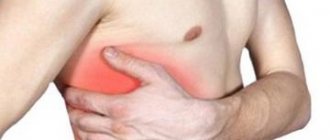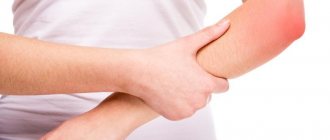Sometimes in the middle of the menstrual cycle, a woman feels discomfort in the lower abdomen and observes scanty bleeding. Many representatives of the fair sex identify such unpleasant symptoms with serious illnesses. But after visiting a gynecologist, it turns out that the cause of such ailments is ovulatory syndrome. Why does this situation happen, how to deal with it and should you be afraid?
Causes of ovulatory syndrome
There is no clear opinion among doctors about what causes this phenomenon. Today, there are several versions of the origin of ovulatory syndrome.
- Every month, 12-14 days before the start of menstruation, ovulation occurs in a woman’s body. This is a natural process that signals the readiness of a mature egg for fertilization. In a normal state, such internal changes go unnoticed. But with ovulatory syndrome, rupture of the follicle in which the egg is located is accompanied by dull, sharp or nagging pain in the lower abdomen. Painful sensations are localized on the right or left. It depends on which side the ovary ovulated.
- Painful ovulation may occur due to adhesions in the pelvis . Adhesions of the fallopian tubes are often a consequence of an inflammatory process. Due to impaired patency, the release of a mature egg is difficult. Without appropriate treatment, the likelihood of pregnancy is minimal.
Don't self-diagnose. After all, such symptoms can be signs of dangerous diseases that require immediate surgical intervention. Only a doctor can determine the exact cause of the ailment and make a diagnosis after a thorough examination.
What does ovulation pain feel like?
Some women experience no pain at all during ovulation. But there are also those women who actually experience mild, moderate or severe pain. Because one egg is released during ovulation, stretching and rupture only affect one ovary. This means that the pain is usually focused on one side of the abdomen or pelvis. Don't be alarmed if ovulation pain switches between cycles. Ovulation pain can range from mild to severe. Some women also notice slight bleeding or discharge during ovulation.
Symptoms
Often the discomfort does not last long and completely disappears after a couple of hours. But there are times when symptoms persist for several days.
Unpleasant sensations intensify when performing sports exercises or during physical activity. In addition, some girls experience weakness, irritability, dizziness, nausea and even vomiting.
Should I worry about ovulation pain?
Ovulation pain is normal for many women, but mid-cycle abdominal cramps can also signal ovarian cysts, ectopic pregnancy, endometriosis, pelvic inflammatory disease, appendicitis or infection. If the pain occurs shortly before your period (rather than two weeks before), it may be implantation bleeding. Contact your doctor if you also experience severe pain that lasts for several days, fever, heavy bleeding that is not due to your period, trouble breathing, painful urination, vomiting, or diarrhea.
How is diagnostics carried out?
In addition to interviewing the patient and in-person examination, smears will be required. The gynecologist will also give you a referral for an ultrasound examination. Modern ultrasound machines will help identify various anomalies in the initial stages.
Additionally, tests are prescribed to check hormone levels. To track their dynamics depending on the phase of the cycle, repeated examinations will be required.
Experts also recommend measuring basal temperature from the day the menstruation stops until the start of a new one. The procedure must be carried out every morning immediately after waking up. To do this, use a regular thermometer, the tip of which should be placed in the anus. The obtained data must be depicted in the form of a graph.
If all indicators are normal, then the gynecologist diagnoses “ovulatory syndrome.”
What are the other symptoms of ovulation?
Abdominal pain can have many different causes, including gas and sexually transmitted diseases. That's why it's important for those trying to conceive to recognize other ovulation symptoms. These include breast tenderness and increased libido, as well as clear, stretchy cervical mucus that resembles egg whites.
Keep in mind that pregnancy is most likely to occur on the day of ovulation and five days before (since sperm can survive in the reproductive tract for five days). If you want to pinpoint your ovulation, consider using tools like ovulation predictor kits, fertility monitors, and basal body temperature thermometers.
How to treat ovulation?
Ovulatory pain doesn't last long, but if you need quick relief, try using over-the-counter pain relievers. For a long-term solution, consider estrogen-progesterone hormonal birth control pills, which suppress ovulation (but not if you're planning a baby).
To prevent ovulatory syndrome, doctors advise:
- avoid lifting heavy objects;
- avoid long walks;
- minimize stress;
- refrain from active sex.
A contrast shower has undeniable benefits for women's health. To do this, first direct a stream of warm water onto your body, and after a couple of seconds switch to cool water. There should be at least five to six such alternations in one session. Remember that cold and hot douches are prohibited during menstruation.
Article source: www.medbooking.com
Obstetrician-gynecologist in Khabarovsk
Ovarian cyst - treatment in Moscow, Life Medic clinic
Ovarian cyst is a common disease that occurs in women, and specialists from the Moscow medical center Life Medic assist patients in treating ovarian cysts using specialized techniques. Unlike polycystic disease, when tissue of underdeveloped eggs accumulates in this organ, when a cyst forms under the ovary, usually the right one, the cortical ovary swells pouch. This happens due to the accumulation of yellow cell fluid in it, which is actively released during the post-ovulation period. However, yellow cells are not always to blame. So:
- a cyst may be an accumulation of dead ovarian tissue, leading to the development of cancer;
- a thick-walled cyst usually results from epidermal deposition;
- a capillary cyst is usually a manifestation of natural organic processes;
- a multi-chamber cyst is a consequence of the accumulation of various tissues, including fluids, which also leads to cancer.
The exact reasons for the formation of cysts in women have not yet been established. Many experts argue that the main causes may be hormonal pathologies. In addition, there have been cases where the formation of a cyst was accompanied by chronic inflammatory processes. Usually, it is not possible to detect the presence of a cyst by observing external manifestations, because the formation of a cyst does not have any symptoms. Most cases are detected during a routine examination by a gynecologist. With excessive physical exertion or very intense sexual intercourse, pain may be felt in the right ovary.
The role of the ovaries in the female body
In size, they are no larger than a peach pit. When there are no pathologies in the body, the left one is always somewhat smaller in size compared to the right one. This organ is a composite organ and is represented by a cortex and connective tissue. Disruption of these components causes general malaise and problems with the functioning of other organs of the female body.
Reproductive function of the ovaries
This paired organ plays a major role in the process of reproduction. After all, they are the ones who produce eggs, which, after fertilization by male sperm, give rise to the birth of a new embryo. They are located on both sides of the uterus, in the pelvic region. Immediately after fertilization, the ovulation process stops and the ovaries begin to produce a temporary protective layer for the future fetus - yellow bodies. However, this layer disappears after the formation of the uterine placenta. Usually replacement occurs after the first 20 weeks of pregnancy.
What to do if your ovaries hurt?
So, what to do if your ovaries hurt. When pain occurs in the pelvic area, rest is necessary. It is necessary to limit yourself from stress, both physical and emotional. It is also worth reconsidering your diet; you may need to go on a diet. In your diet, you should limit yourself from salty and excessively fatty foods. It is recommended to consume more dairy products, fresh fruits and vegetables.
Folk remedies for such a symptom are absolutely not advisable. But after consulting a doctor, you can take mud baths and salt baths. Medicinal decoctions should also be taken in consultation with your gynecologist. An experienced doctor will also tell you what to do if your ovaries hurt.
If acute pain occurs, you must call an ambulance. You should not try to figure out the reasons on your own, even if this has been observed and successfully eliminated before.
Ovarian cancer
Ovarian cancer is detected in older women up to 70 years of age. In more than thirty percent of cases it leads to death. Basically, such malignant formations in the reproductive system are divided into the following groups:
- initial, when a cancerous tumor arose in the ovary itself for no apparent reason;
- secondary, when cancer causes the death of benign cells;
- Metastatic cancer appears due to cancer cells entering the ovaries from another organ through the blood.
The causes of cancer cells in the body are still unknown. Doctors attribute most cases to age and heredity. In addition, hormonal processes are of no small importance.
The signs of a malignant tumor are quite obvious. So in cancer there are:
- a feeling of discomfort reminiscent of a digestive tract disorder;
- persistent feeling of fatigue;
- constant feeling of the presence of a foreign object in the abdomen.
The growth of the tumor causes pain in the left ovary or in the right and difficulty urinating. In addition to a decrease in the amount of menstrual flow, the woman is attacked by apathy and depression does not leave her.
Pain in the ovaries when taking birth control pills
More than half of the world's women prefer to avoid unwanted pregnancy by using oral contraceptives. However, most of them have no idea what exactly the effect of such pills on the body entails. Thus, most of these drugs accelerate or inhibit hormonal processes. This is mainly a consequence of the need to increase the production of estrogen, which activates the menstrual process and prevents pregnancy. If, along with the right one, the left ovary hurts, then the reasons are precisely this effect on the uterus. Typically, ovarian colitis occurs in 90% of such patients in the first three months after starting medication. This is normal if, along with the right one, the left ovary colitises. However, if the pain does not go away longer than this, then perhaps due to a hormonal imbalance, a cyst or something else has formed in the ovary.
Abortion as a cause of pain in the ovaries
An incorrectly performed abortion procedure can cause pain in the ovaries due to infections or damage to the ovaries when the fetus is removed. Both ovaries can hurt at the same time. This is one of the few reasons why the left ovary hurts, since in most cases the pain radiates to the right. Typically, such symptoms appear exclusively in the first week after the procedure. In addition, the abortion procedure can lead to disruption of menstrual processes and the functioning of endocrine organs. But most of all, the organs of the woman’s reproductive system suffer from this procedure, mechanically or otherwise. Therefore, after an abortion, the risk of infertility is very high.










